Appendicitis: Nursing Care, Growth, and Development of a Child Patient
VerifiedAdded on 2021/04/16
|9
|2652
|57
Report
AI Summary
This report examines the nursing care of a 10-year-old patient, Anne, who underwent an appendectomy due to appendicitis. It delves into the pathophysiology of appendicitis, emphasizing the importance of pain and tenderness management, and IV fluids. The report highlights the application of developmental theories, specifically Erikson's stages of psychosocial development, to understand the patient's behavior and tailor nursing care accordingly. It stresses the significance of family-centered care, acknowledging the family's role in the child's well-being and the impact of hospitalization on both the child and the family, including socioeconomic factors and cultural beliefs. The report also addresses the potential complications related to medication administration and the placement of medical devices, and emphasizes the need for a holistic nursing approach that considers the patient's physical, emotional, and spiritual needs. It concludes by advocating for careful nursing interventions considering the child's underdeveloped organ system, and the importance of including parents in the decision-making process to improve health outcomes.
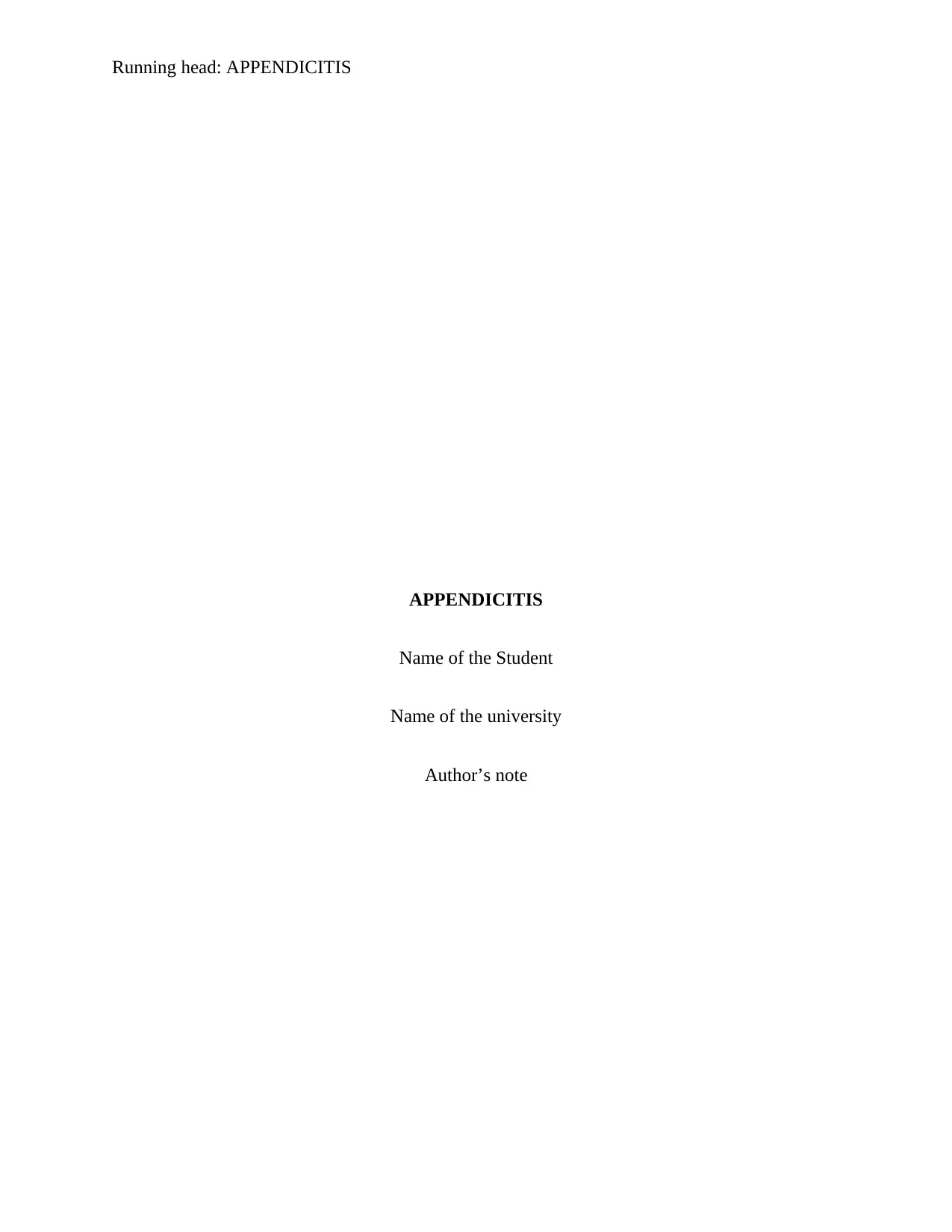
Running head: APPENDICITIS
APPENDICITIS
Name of the Student
Name of the university
Author’s note
APPENDICITIS
Name of the Student
Name of the university
Author’s note
Paraphrase This Document
Need a fresh take? Get an instant paraphrase of this document with our AI Paraphraser
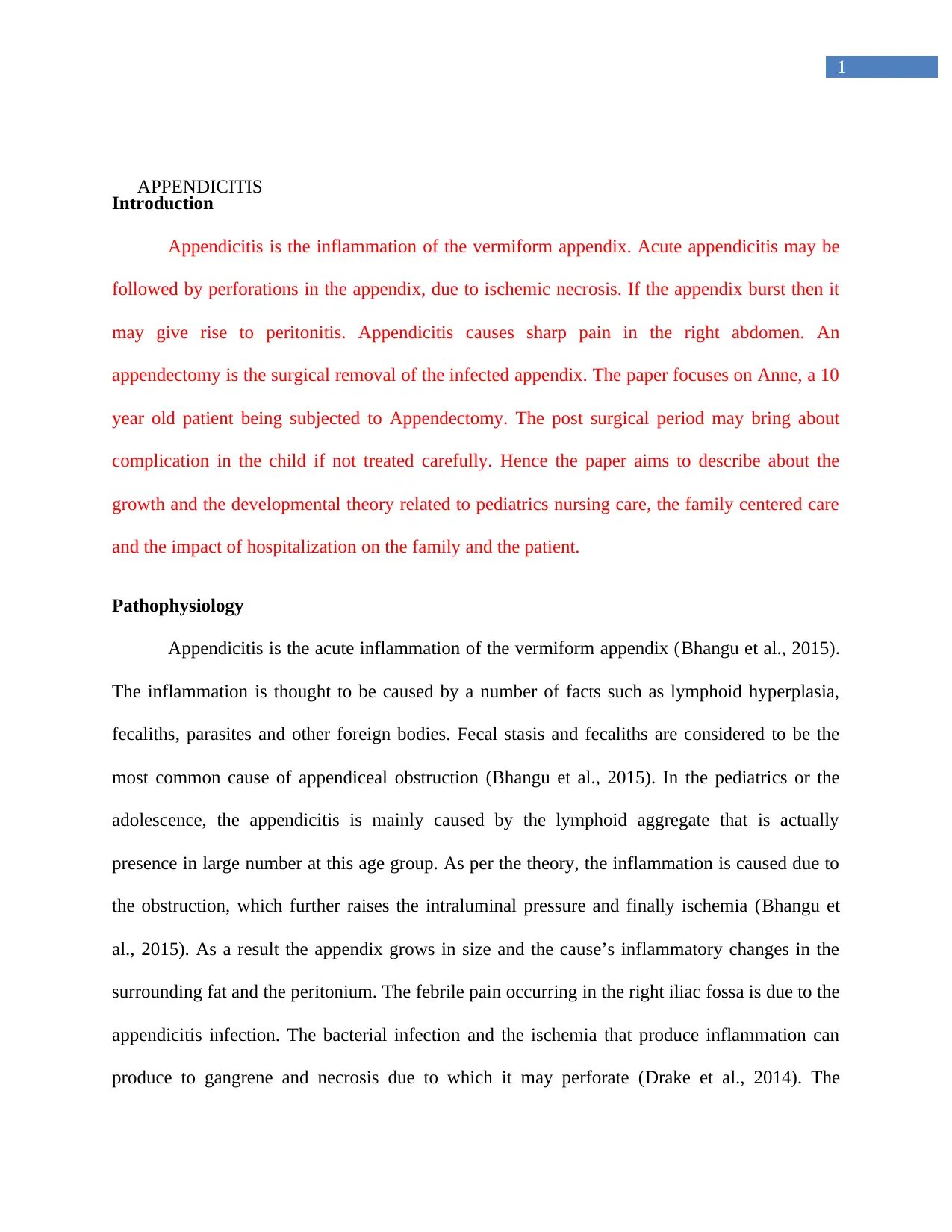
1
APPENDICITIS
Introduction
Appendicitis is the inflammation of the vermiform appendix. Acute appendicitis may be
followed by perforations in the appendix, due to ischemic necrosis. If the appendix burst then it
may give rise to peritonitis. Appendicitis causes sharp pain in the right abdomen. An
appendectomy is the surgical removal of the infected appendix. The paper focuses on Anne, a 10
year old patient being subjected to Appendectomy. The post surgical period may bring about
complication in the child if not treated carefully. Hence the paper aims to describe about the
growth and the developmental theory related to pediatrics nursing care, the family centered care
and the impact of hospitalization on the family and the patient.
Pathophysiology
Appendicitis is the acute inflammation of the vermiform appendix (Bhangu et al., 2015).
The inflammation is thought to be caused by a number of facts such as lymphoid hyperplasia,
fecaliths, parasites and other foreign bodies. Fecal stasis and fecaliths are considered to be the
most common cause of appendiceal obstruction (Bhangu et al., 2015). In the pediatrics or the
adolescence, the appendicitis is mainly caused by the lymphoid aggregate that is actually
presence in large number at this age group. As per the theory, the inflammation is caused due to
the obstruction, which further raises the intraluminal pressure and finally ischemia (Bhangu et
al., 2015). As a result the appendix grows in size and the cause’s inflammatory changes in the
surrounding fat and the peritonium. The febrile pain occurring in the right iliac fossa is due to the
appendicitis infection. The bacterial infection and the ischemia that produce inflammation can
produce to gangrene and necrosis due to which it may perforate (Drake et al., 2014). The
APPENDICITIS
Introduction
Appendicitis is the inflammation of the vermiform appendix. Acute appendicitis may be
followed by perforations in the appendix, due to ischemic necrosis. If the appendix burst then it
may give rise to peritonitis. Appendicitis causes sharp pain in the right abdomen. An
appendectomy is the surgical removal of the infected appendix. The paper focuses on Anne, a 10
year old patient being subjected to Appendectomy. The post surgical period may bring about
complication in the child if not treated carefully. Hence the paper aims to describe about the
growth and the developmental theory related to pediatrics nursing care, the family centered care
and the impact of hospitalization on the family and the patient.
Pathophysiology
Appendicitis is the acute inflammation of the vermiform appendix (Bhangu et al., 2015).
The inflammation is thought to be caused by a number of facts such as lymphoid hyperplasia,
fecaliths, parasites and other foreign bodies. Fecal stasis and fecaliths are considered to be the
most common cause of appendiceal obstruction (Bhangu et al., 2015). In the pediatrics or the
adolescence, the appendicitis is mainly caused by the lymphoid aggregate that is actually
presence in large number at this age group. As per the theory, the inflammation is caused due to
the obstruction, which further raises the intraluminal pressure and finally ischemia (Bhangu et
al., 2015). As a result the appendix grows in size and the cause’s inflammatory changes in the
surrounding fat and the peritonium. The febrile pain occurring in the right iliac fossa is due to the
appendicitis infection. The bacterial infection and the ischemia that produce inflammation can
produce to gangrene and necrosis due to which it may perforate (Drake et al., 2014). The
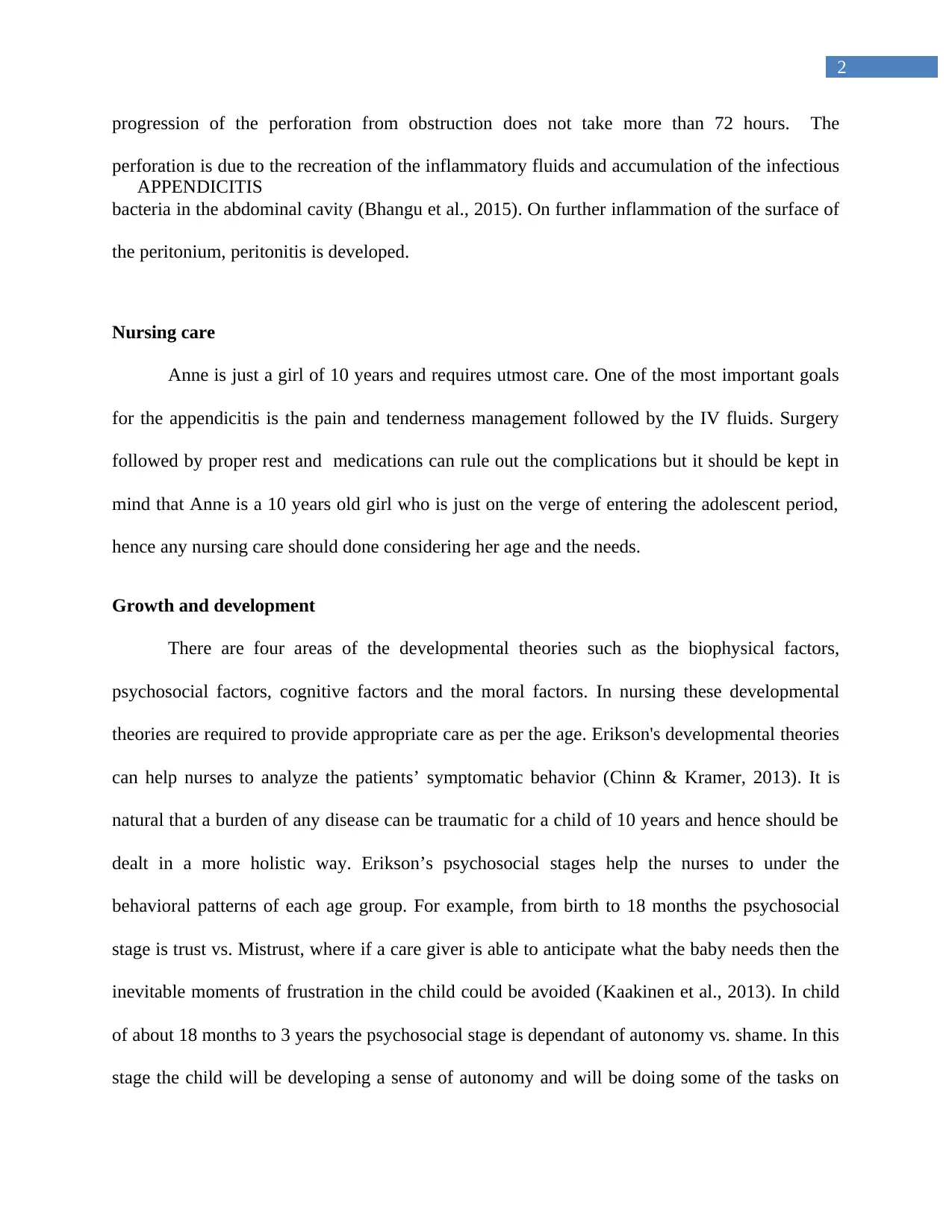
2
APPENDICITIS
progression of the perforation from obstruction does not take more than 72 hours. The
perforation is due to the recreation of the inflammatory fluids and accumulation of the infectious
bacteria in the abdominal cavity (Bhangu et al., 2015). On further inflammation of the surface of
the peritonium, peritonitis is developed.
Nursing care
Anne is just a girl of 10 years and requires utmost care. One of the most important goals
for the appendicitis is the pain and tenderness management followed by the IV fluids. Surgery
followed by proper rest and medications can rule out the complications but it should be kept in
mind that Anne is a 10 years old girl who is just on the verge of entering the adolescent period,
hence any nursing care should done considering her age and the needs.
Growth and development
There are four areas of the developmental theories such as the biophysical factors,
psychosocial factors, cognitive factors and the moral factors. In nursing these developmental
theories are required to provide appropriate care as per the age. Erikson's developmental theories
can help nurses to analyze the patients’ symptomatic behavior (Chinn & Kramer, 2013). It is
natural that a burden of any disease can be traumatic for a child of 10 years and hence should be
dealt in a more holistic way. Erikson’s psychosocial stages help the nurses to under the
behavioral patterns of each age group. For example, from birth to 18 months the psychosocial
stage is trust vs. Mistrust, where if a care giver is able to anticipate what the baby needs then the
inevitable moments of frustration in the child could be avoided (Kaakinen et al., 2013). In child
of about 18 months to 3 years the psychosocial stage is dependant of autonomy vs. shame. In this
stage the child will be developing a sense of autonomy and will be doing some of the tasks on
APPENDICITIS
progression of the perforation from obstruction does not take more than 72 hours. The
perforation is due to the recreation of the inflammatory fluids and accumulation of the infectious
bacteria in the abdominal cavity (Bhangu et al., 2015). On further inflammation of the surface of
the peritonium, peritonitis is developed.
Nursing care
Anne is just a girl of 10 years and requires utmost care. One of the most important goals
for the appendicitis is the pain and tenderness management followed by the IV fluids. Surgery
followed by proper rest and medications can rule out the complications but it should be kept in
mind that Anne is a 10 years old girl who is just on the verge of entering the adolescent period,
hence any nursing care should done considering her age and the needs.
Growth and development
There are four areas of the developmental theories such as the biophysical factors,
psychosocial factors, cognitive factors and the moral factors. In nursing these developmental
theories are required to provide appropriate care as per the age. Erikson's developmental theories
can help nurses to analyze the patients’ symptomatic behavior (Chinn & Kramer, 2013). It is
natural that a burden of any disease can be traumatic for a child of 10 years and hence should be
dealt in a more holistic way. Erikson’s psychosocial stages help the nurses to under the
behavioral patterns of each age group. For example, from birth to 18 months the psychosocial
stage is trust vs. Mistrust, where if a care giver is able to anticipate what the baby needs then the
inevitable moments of frustration in the child could be avoided (Kaakinen et al., 2013). In child
of about 18 months to 3 years the psychosocial stage is dependant of autonomy vs. shame. In this
stage the child will be developing a sense of autonomy and will be doing some of the tasks on
⊘ This is a preview!⊘
Do you want full access?
Subscribe today to unlock all pages.

Trusted by 1+ million students worldwide
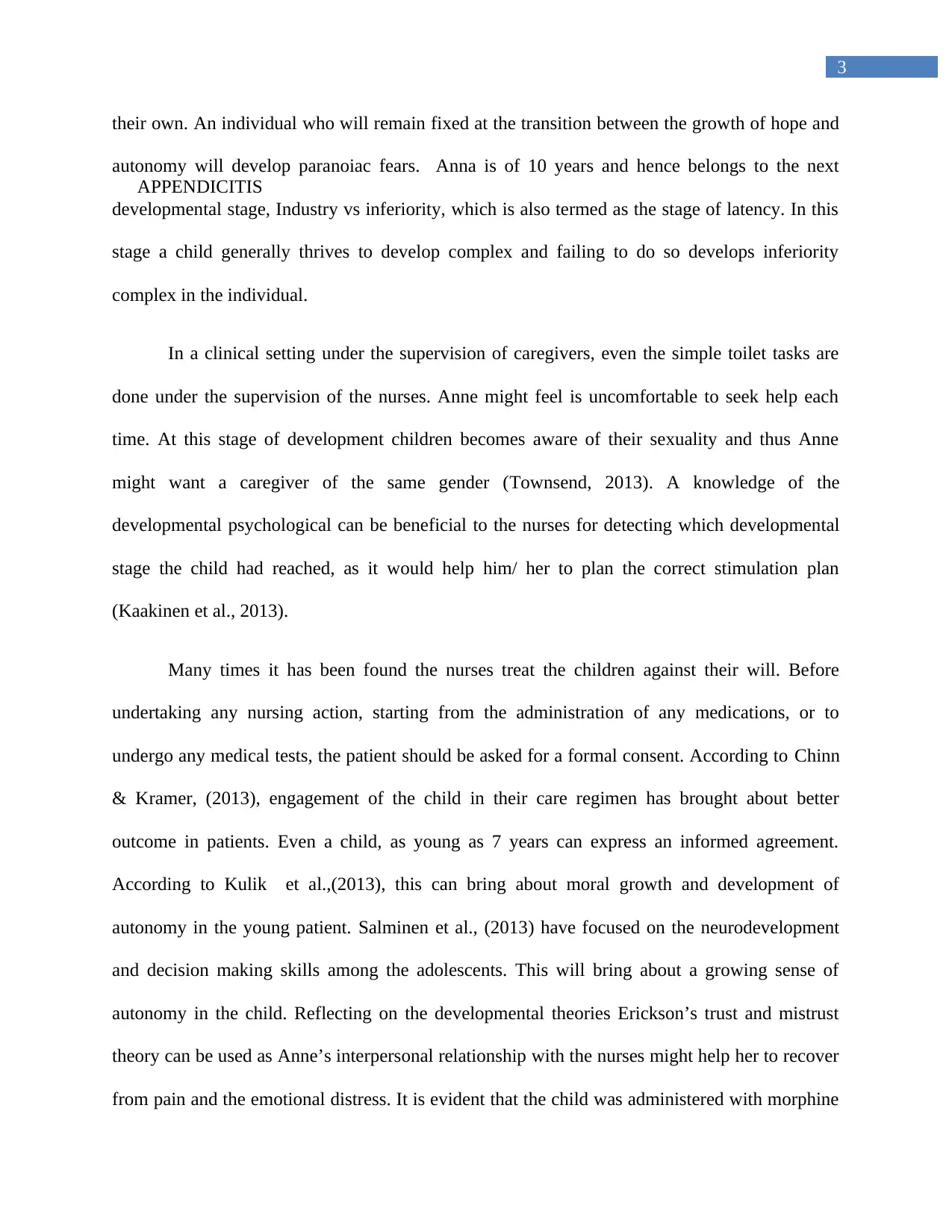
3
APPENDICITIS
their own. An individual who will remain fixed at the transition between the growth of hope and
autonomy will develop paranoiac fears. Anna is of 10 years and hence belongs to the next
developmental stage, Industry vs inferiority, which is also termed as the stage of latency. In this
stage a child generally thrives to develop complex and failing to do so develops inferiority
complex in the individual.
In a clinical setting under the supervision of caregivers, even the simple toilet tasks are
done under the supervision of the nurses. Anne might feel is uncomfortable to seek help each
time. At this stage of development children becomes aware of their sexuality and thus Anne
might want a caregiver of the same gender (Townsend, 2013). A knowledge of the
developmental psychological can be beneficial to the nurses for detecting which developmental
stage the child had reached, as it would help him/ her to plan the correct stimulation plan
(Kaakinen et al., 2013).
Many times it has been found the nurses treat the children against their will. Before
undertaking any nursing action, starting from the administration of any medications, or to
undergo any medical tests, the patient should be asked for a formal consent. According to Chinn
& Kramer, (2013), engagement of the child in their care regimen has brought about better
outcome in patients. Even a child, as young as 7 years can express an informed agreement.
According to Kulik et al.,(2013), this can bring about moral growth and development of
autonomy in the young patient. Salminen et al., (2013) have focused on the neurodevelopment
and decision making skills among the adolescents. This will bring about a growing sense of
autonomy in the child. Reflecting on the developmental theories Erickson’s trust and mistrust
theory can be used as Anne’s interpersonal relationship with the nurses might help her to recover
from pain and the emotional distress. It is evident that the child was administered with morphine
APPENDICITIS
their own. An individual who will remain fixed at the transition between the growth of hope and
autonomy will develop paranoiac fears. Anna is of 10 years and hence belongs to the next
developmental stage, Industry vs inferiority, which is also termed as the stage of latency. In this
stage a child generally thrives to develop complex and failing to do so develops inferiority
complex in the individual.
In a clinical setting under the supervision of caregivers, even the simple toilet tasks are
done under the supervision of the nurses. Anne might feel is uncomfortable to seek help each
time. At this stage of development children becomes aware of their sexuality and thus Anne
might want a caregiver of the same gender (Townsend, 2013). A knowledge of the
developmental psychological can be beneficial to the nurses for detecting which developmental
stage the child had reached, as it would help him/ her to plan the correct stimulation plan
(Kaakinen et al., 2013).
Many times it has been found the nurses treat the children against their will. Before
undertaking any nursing action, starting from the administration of any medications, or to
undergo any medical tests, the patient should be asked for a formal consent. According to Chinn
& Kramer, (2013), engagement of the child in their care regimen has brought about better
outcome in patients. Even a child, as young as 7 years can express an informed agreement.
According to Kulik et al.,(2013), this can bring about moral growth and development of
autonomy in the young patient. Salminen et al., (2013) have focused on the neurodevelopment
and decision making skills among the adolescents. This will bring about a growing sense of
autonomy in the child. Reflecting on the developmental theories Erickson’s trust and mistrust
theory can be used as Anne’s interpersonal relationship with the nurses might help her to recover
from pain and the emotional distress. It is evident that the child was administered with morphine
Paraphrase This Document
Need a fresh take? Get an instant paraphrase of this document with our AI Paraphraser
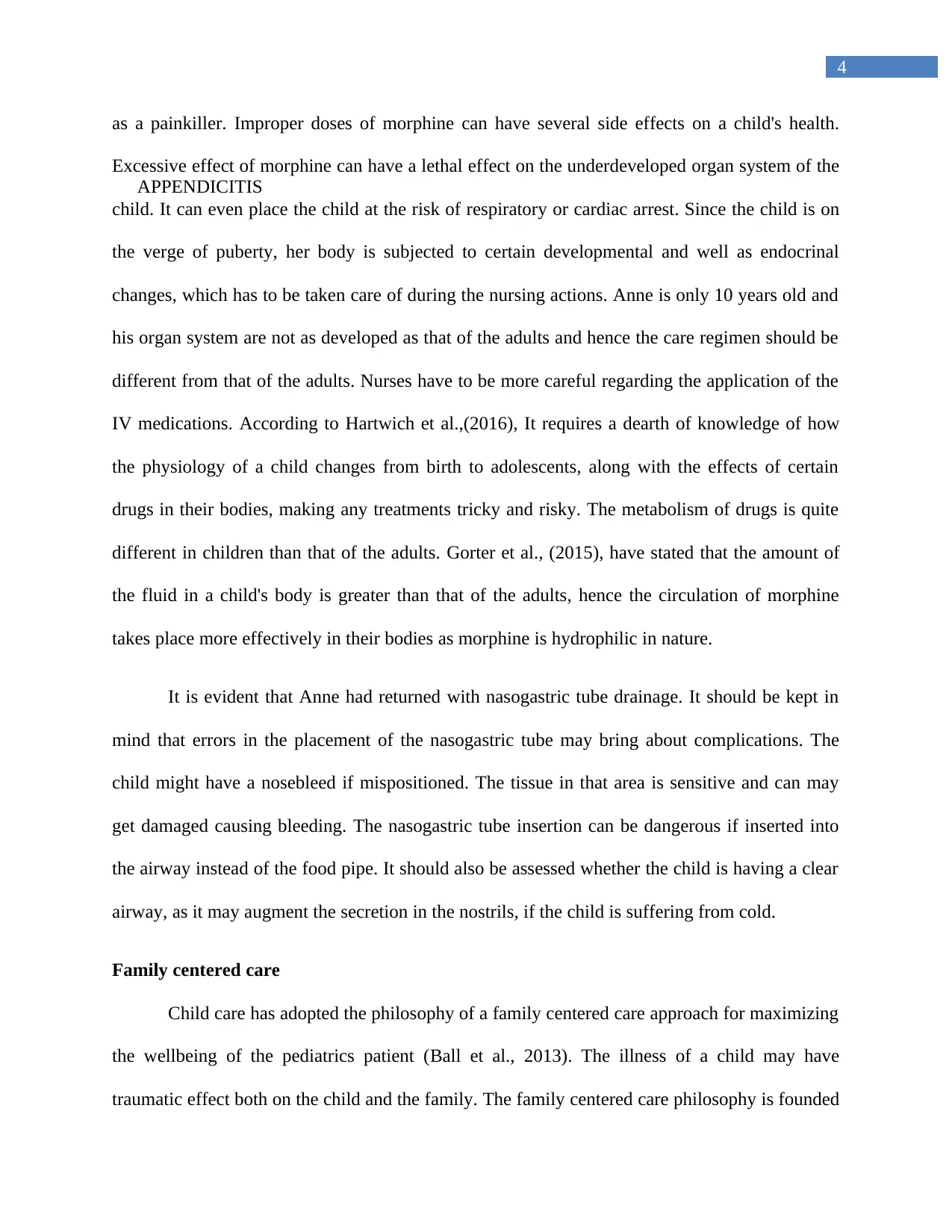
4
APPENDICITIS
as a painkiller. Improper doses of morphine can have several side effects on a child's health.
Excessive effect of morphine can have a lethal effect on the underdeveloped organ system of the
child. It can even place the child at the risk of respiratory or cardiac arrest. Since the child is on
the verge of puberty, her body is subjected to certain developmental and well as endocrinal
changes, which has to be taken care of during the nursing actions. Anne is only 10 years old and
his organ system are not as developed as that of the adults and hence the care regimen should be
different from that of the adults. Nurses have to be more careful regarding the application of the
IV medications. According to Hartwich et al.,(2016), It requires a dearth of knowledge of how
the physiology of a child changes from birth to adolescents, along with the effects of certain
drugs in their bodies, making any treatments tricky and risky. The metabolism of drugs is quite
different in children than that of the adults. Gorter et al., (2015), have stated that the amount of
the fluid in a child's body is greater than that of the adults, hence the circulation of morphine
takes place more effectively in their bodies as morphine is hydrophilic in nature.
It is evident that Anne had returned with nasogastric tube drainage. It should be kept in
mind that errors in the placement of the nasogastric tube may bring about complications. The
child might have a nosebleed if mispositioned. The tissue in that area is sensitive and can may
get damaged causing bleeding. The nasogastric tube insertion can be dangerous if inserted into
the airway instead of the food pipe. It should also be assessed whether the child is having a clear
airway, as it may augment the secretion in the nostrils, if the child is suffering from cold.
Family centered care
Child care has adopted the philosophy of a family centered care approach for maximizing
the wellbeing of the pediatrics patient (Ball et al., 2013). The illness of a child may have
traumatic effect both on the child and the family. The family centered care philosophy is founded
APPENDICITIS
as a painkiller. Improper doses of morphine can have several side effects on a child's health.
Excessive effect of morphine can have a lethal effect on the underdeveloped organ system of the
child. It can even place the child at the risk of respiratory or cardiac arrest. Since the child is on
the verge of puberty, her body is subjected to certain developmental and well as endocrinal
changes, which has to be taken care of during the nursing actions. Anne is only 10 years old and
his organ system are not as developed as that of the adults and hence the care regimen should be
different from that of the adults. Nurses have to be more careful regarding the application of the
IV medications. According to Hartwich et al.,(2016), It requires a dearth of knowledge of how
the physiology of a child changes from birth to adolescents, along with the effects of certain
drugs in their bodies, making any treatments tricky and risky. The metabolism of drugs is quite
different in children than that of the adults. Gorter et al., (2015), have stated that the amount of
the fluid in a child's body is greater than that of the adults, hence the circulation of morphine
takes place more effectively in their bodies as morphine is hydrophilic in nature.
It is evident that Anne had returned with nasogastric tube drainage. It should be kept in
mind that errors in the placement of the nasogastric tube may bring about complications. The
child might have a nosebleed if mispositioned. The tissue in that area is sensitive and can may
get damaged causing bleeding. The nasogastric tube insertion can be dangerous if inserted into
the airway instead of the food pipe. It should also be assessed whether the child is having a clear
airway, as it may augment the secretion in the nostrils, if the child is suffering from cold.
Family centered care
Child care has adopted the philosophy of a family centered care approach for maximizing
the wellbeing of the pediatrics patient (Ball et al., 2013). The illness of a child may have
traumatic effect both on the child and the family. The family centered care philosophy is founded

5
APPENDICITIS
in collaboration with the nurses, family, hospital and the other members of the collaborative team
(Davidson et al., 2013). Nurses should work in collaboration with the families for developing the
best plan of care for the patient (Ball et al., 2013). It should be remembered that parents are the
micro-system of the child's ecology and are experts in their child's care. The presence of Anne's
family members during the health related procedures such as, ultrasounds or during the dressing
of the wounds can be relieving for both the child and the family. Families come with different
cultures and one of the roles of the nurses is to acknowledge and accepts the diversity (Festini,
2014). Cultural and spiritual beliefs have an immense effect on a child's wellbeing. Nurses
should work with the families such that the practices can be used in the care of the child if
suitable. For example, some families believe on religious practices such as prayers. The socio-
economic status of the family can have a profound effect on the type of care provided to the child
(Festini, 2014).
Effect of hospitalization on the child and the family
The case study reveals that Anne is the oldest among the five children. Hence their elder
sister's illness might have caused anxiety in them to. Furthermore it is also evident that her parent
owns and runs an Indian restaurant. Such a surgery and treatment can bring about high cost
burden upon them. The hospital environment including the attitude and the behavior of the
nurses can affect the well being of the patient. The hospital environment should be non hostile;
the course of the treatment should be transparent keeping the patient's interest at the foremost
(Macy,2013). A multidisciplinary should be appointed in case the case turns critical. Nurses
should be careful while monitoring the vital signs and administering medications.
APPENDICITIS
in collaboration with the nurses, family, hospital and the other members of the collaborative team
(Davidson et al., 2013). Nurses should work in collaboration with the families for developing the
best plan of care for the patient (Ball et al., 2013). It should be remembered that parents are the
micro-system of the child's ecology and are experts in their child's care. The presence of Anne's
family members during the health related procedures such as, ultrasounds or during the dressing
of the wounds can be relieving for both the child and the family. Families come with different
cultures and one of the roles of the nurses is to acknowledge and accepts the diversity (Festini,
2014). Cultural and spiritual beliefs have an immense effect on a child's wellbeing. Nurses
should work with the families such that the practices can be used in the care of the child if
suitable. For example, some families believe on religious practices such as prayers. The socio-
economic status of the family can have a profound effect on the type of care provided to the child
(Festini, 2014).
Effect of hospitalization on the child and the family
The case study reveals that Anne is the oldest among the five children. Hence their elder
sister's illness might have caused anxiety in them to. Furthermore it is also evident that her parent
owns and runs an Indian restaurant. Such a surgery and treatment can bring about high cost
burden upon them. The hospital environment including the attitude and the behavior of the
nurses can affect the well being of the patient. The hospital environment should be non hostile;
the course of the treatment should be transparent keeping the patient's interest at the foremost
(Macy,2013). A multidisciplinary should be appointed in case the case turns critical. Nurses
should be careful while monitoring the vital signs and administering medications.
⊘ This is a preview!⊘
Do you want full access?
Subscribe today to unlock all pages.

Trusted by 1+ million students worldwide
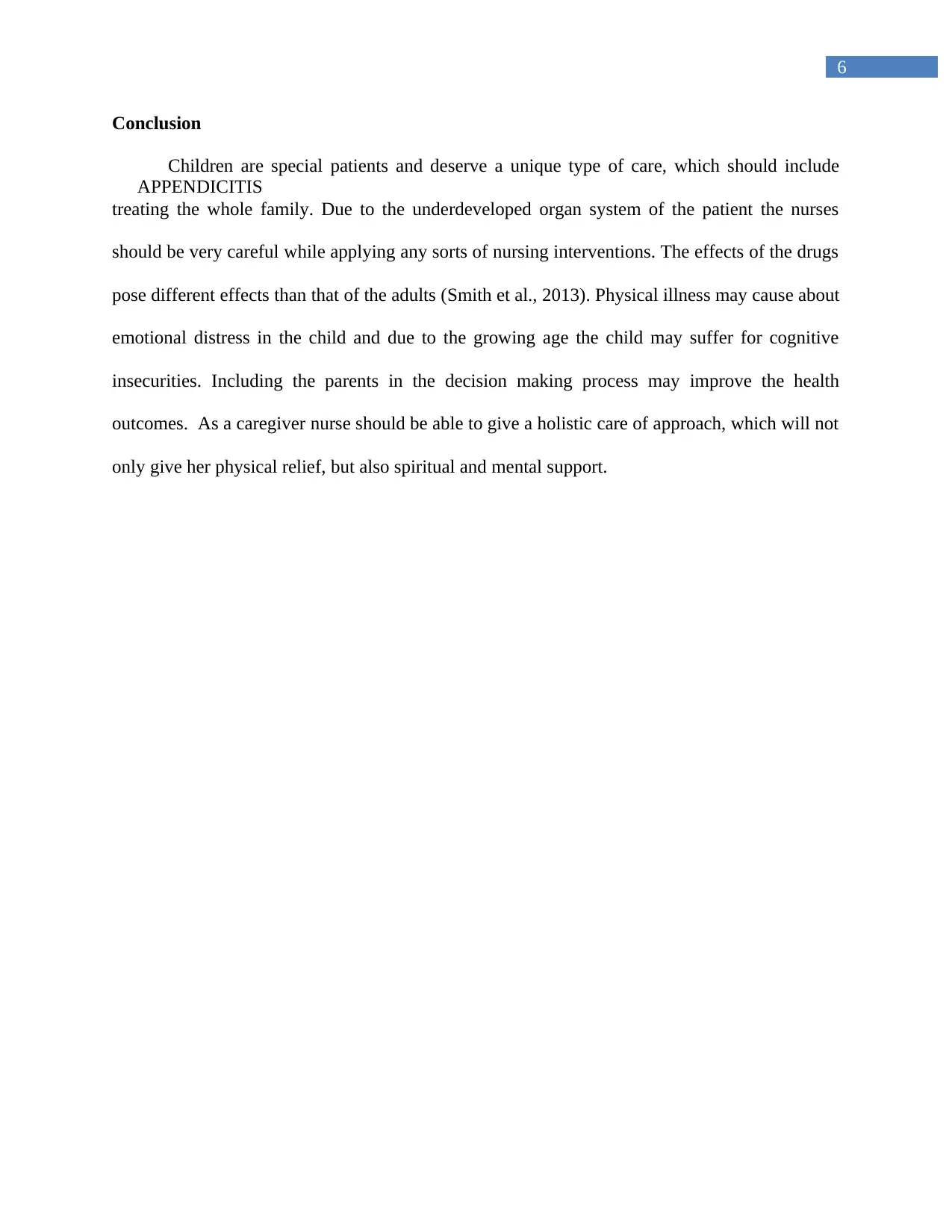
6
APPENDICITIS
Conclusion
Children are special patients and deserve a unique type of care, which should include
treating the whole family. Due to the underdeveloped organ system of the patient the nurses
should be very careful while applying any sorts of nursing interventions. The effects of the drugs
pose different effects than that of the adults (Smith et al., 2013). Physical illness may cause about
emotional distress in the child and due to the growing age the child may suffer for cognitive
insecurities. Including the parents in the decision making process may improve the health
outcomes. As a caregiver nurse should be able to give a holistic care of approach, which will not
only give her physical relief, but also spiritual and mental support.
APPENDICITIS
Conclusion
Children are special patients and deserve a unique type of care, which should include
treating the whole family. Due to the underdeveloped organ system of the patient the nurses
should be very careful while applying any sorts of nursing interventions. The effects of the drugs
pose different effects than that of the adults (Smith et al., 2013). Physical illness may cause about
emotional distress in the child and due to the growing age the child may suffer for cognitive
insecurities. Including the parents in the decision making process may improve the health
outcomes. As a caregiver nurse should be able to give a holistic care of approach, which will not
only give her physical relief, but also spiritual and mental support.
Paraphrase This Document
Need a fresh take? Get an instant paraphrase of this document with our AI Paraphraser
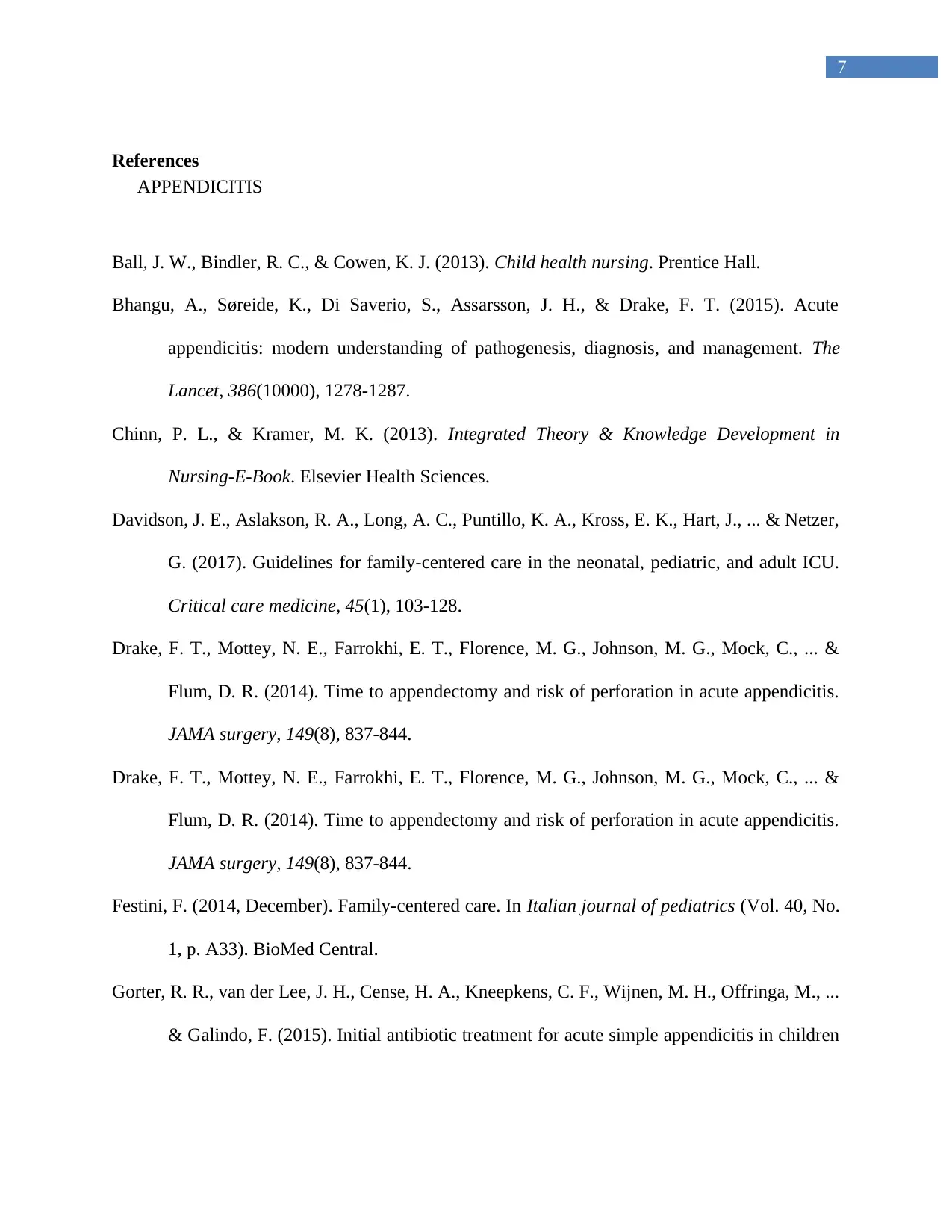
7
APPENDICITIS
References
Ball, J. W., Bindler, R. C., & Cowen, K. J. (2013). Child health nursing. Prentice Hall.
Bhangu, A., Søreide, K., Di Saverio, S., Assarsson, J. H., & Drake, F. T. (2015). Acute
appendicitis: modern understanding of pathogenesis, diagnosis, and management. The
Lancet, 386(10000), 1278-1287.
Chinn, P. L., & Kramer, M. K. (2013). Integrated Theory & Knowledge Development in
Nursing-E-Book. Elsevier Health Sciences.
Davidson, J. E., Aslakson, R. A., Long, A. C., Puntillo, K. A., Kross, E. K., Hart, J., ... & Netzer,
G. (2017). Guidelines for family-centered care in the neonatal, pediatric, and adult ICU.
Critical care medicine, 45(1), 103-128.
Drake, F. T., Mottey, N. E., Farrokhi, E. T., Florence, M. G., Johnson, M. G., Mock, C., ... &
Flum, D. R. (2014). Time to appendectomy and risk of perforation in acute appendicitis.
JAMA surgery, 149(8), 837-844.
Drake, F. T., Mottey, N. E., Farrokhi, E. T., Florence, M. G., Johnson, M. G., Mock, C., ... &
Flum, D. R. (2014). Time to appendectomy and risk of perforation in acute appendicitis.
JAMA surgery, 149(8), 837-844.
Festini, F. (2014, December). Family-centered care. In Italian journal of pediatrics (Vol. 40, No.
1, p. A33). BioMed Central.
Gorter, R. R., van der Lee, J. H., Cense, H. A., Kneepkens, C. F., Wijnen, M. H., Offringa, M., ...
& Galindo, F. (2015). Initial antibiotic treatment for acute simple appendicitis in children
APPENDICITIS
References
Ball, J. W., Bindler, R. C., & Cowen, K. J. (2013). Child health nursing. Prentice Hall.
Bhangu, A., Søreide, K., Di Saverio, S., Assarsson, J. H., & Drake, F. T. (2015). Acute
appendicitis: modern understanding of pathogenesis, diagnosis, and management. The
Lancet, 386(10000), 1278-1287.
Chinn, P. L., & Kramer, M. K. (2013). Integrated Theory & Knowledge Development in
Nursing-E-Book. Elsevier Health Sciences.
Davidson, J. E., Aslakson, R. A., Long, A. C., Puntillo, K. A., Kross, E. K., Hart, J., ... & Netzer,
G. (2017). Guidelines for family-centered care in the neonatal, pediatric, and adult ICU.
Critical care medicine, 45(1), 103-128.
Drake, F. T., Mottey, N. E., Farrokhi, E. T., Florence, M. G., Johnson, M. G., Mock, C., ... &
Flum, D. R. (2014). Time to appendectomy and risk of perforation in acute appendicitis.
JAMA surgery, 149(8), 837-844.
Drake, F. T., Mottey, N. E., Farrokhi, E. T., Florence, M. G., Johnson, M. G., Mock, C., ... &
Flum, D. R. (2014). Time to appendectomy and risk of perforation in acute appendicitis.
JAMA surgery, 149(8), 837-844.
Festini, F. (2014, December). Family-centered care. In Italian journal of pediatrics (Vol. 40, No.
1, p. A33). BioMed Central.
Gorter, R. R., van der Lee, J. H., Cense, H. A., Kneepkens, C. F., Wijnen, M. H., Offringa, M., ...
& Galindo, F. (2015). Initial antibiotic treatment for acute simple appendicitis in children

8
APPENDICITIS
is safe: short-term results from a multicenter, prospective cohort study. Surgery, 157(5),
916-923.
Hartwich, J., Luks, F. I., Watson-Smith, D., Kurkchubasche, A. G., Muratore, C. S., Wills, H. E.,
& Tracy, T. F. (2016). Nonoperative treatment of acute appendicitis in children: a
feasibility study. Journal of pediatric surgery, 51(1), 111-116.
Kaakinen, J. R., Coehlo, D. P., Steele, R., Tabacco, A., & Hanson, S. M. H. (2014). Family
health care nursing: Theory, practice, and research. FA Davis.
Kulik, D. M., Uleryk, E. M., & Maguire, J. L. (2013). Does this child have appendicitis? A
systematic review of clinical prediction rules for children with acute abdominal pain.
Journal of clinical epidemiology, 66(1), 95-104.
Macy, K. (2013). Family-Centered Care. In Encyclopedia of Autism Spectrum Disorders (pp.
1252-1253). Springer New York.
Salminen, P., Paajanen, H., Rautio, T., Nordström, P., Aarnio, M., Rantanen, T., ... & Sand, J.
(2015). Antibiotic therapy vs appendectomy for treatment of uncomplicated acute
appendicitis: the APPAC randomized clinical trial. Jama, 313(23), 2340-2348.
Smith, J., Swallow, V., & Coyne, I. (2015). Involving parents in managing their child's long-term
condition—A concept synthesis of family-centered care and partnership-in-care. Journal
of Pediatric Nursing: Nursing Care of Children and Families, 30(1), 143-159.
Townsend, M. C. (2013). Essentials of psychiatric mental health nursing: Concepts of care in
evidence-based practice. FA Davis.
APPENDICITIS
is safe: short-term results from a multicenter, prospective cohort study. Surgery, 157(5),
916-923.
Hartwich, J., Luks, F. I., Watson-Smith, D., Kurkchubasche, A. G., Muratore, C. S., Wills, H. E.,
& Tracy, T. F. (2016). Nonoperative treatment of acute appendicitis in children: a
feasibility study. Journal of pediatric surgery, 51(1), 111-116.
Kaakinen, J. R., Coehlo, D. P., Steele, R., Tabacco, A., & Hanson, S. M. H. (2014). Family
health care nursing: Theory, practice, and research. FA Davis.
Kulik, D. M., Uleryk, E. M., & Maguire, J. L. (2013). Does this child have appendicitis? A
systematic review of clinical prediction rules for children with acute abdominal pain.
Journal of clinical epidemiology, 66(1), 95-104.
Macy, K. (2013). Family-Centered Care. In Encyclopedia of Autism Spectrum Disorders (pp.
1252-1253). Springer New York.
Salminen, P., Paajanen, H., Rautio, T., Nordström, P., Aarnio, M., Rantanen, T., ... & Sand, J.
(2015). Antibiotic therapy vs appendectomy for treatment of uncomplicated acute
appendicitis: the APPAC randomized clinical trial. Jama, 313(23), 2340-2348.
Smith, J., Swallow, V., & Coyne, I. (2015). Involving parents in managing their child's long-term
condition—A concept synthesis of family-centered care and partnership-in-care. Journal
of Pediatric Nursing: Nursing Care of Children and Families, 30(1), 143-159.
Townsend, M. C. (2013). Essentials of psychiatric mental health nursing: Concepts of care in
evidence-based practice. FA Davis.
⊘ This is a preview!⊘
Do you want full access?
Subscribe today to unlock all pages.

Trusted by 1+ million students worldwide
1 out of 9
Related Documents
Your All-in-One AI-Powered Toolkit for Academic Success.
+13062052269
info@desklib.com
Available 24*7 on WhatsApp / Email
![[object Object]](/_next/static/media/star-bottom.7253800d.svg)
Unlock your academic potential
Copyright © 2020–2025 A2Z Services. All Rights Reserved. Developed and managed by ZUCOL.





